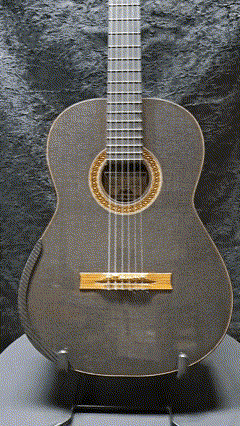Frequently Asked Questions
Spruce or Cedar?
There are a lot of different opinions. In the end, it may be a matter of personal preference. Furthermore, a lot of the guitar's performance is dependent on how it's built. Sometimes, it can be difficult to tell the difference between spruce and cedar in a blind hearing test.
Cosmetic: Cedar looks darker than spruce. Cedar is a little softer than spruce, so will be easier to dent.
Tone: A cedar top may sound warmer and richer than spruce given the same guitar design. The spruce top may sound brighter and clearer.
Projection: A spruce top may project sound better into the audience. A cedar top may provide more sound/feedback to the player.
Aging: While a cedar top may reach its best potential sound within a few years, a spruce top may ultimately take longer to reach its best potential, but its ultimate sound may be better than the cedar.
Lattice or Fan Bracing?
There are probably nearly as many different bracing patterns as luthiers. Most of them can produce an excellent guitar, with variations in tone and power. I usually use lattice bracing (left), but will do fan bracing (right) on request.
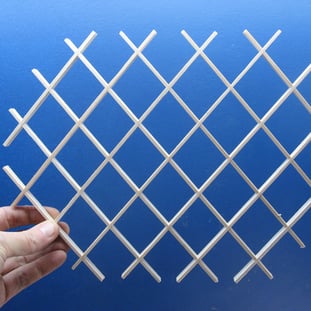
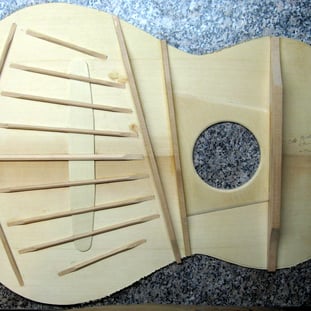
Floating Saddle Block
The saddle block is the part that holds the bone saddle - and I've built it as a removable cap. On the underside, it's got a plug of wood that fits precisely into a socket in the rest of the bridge - On the left hand side of the photo, I'm showing the underside of the prototype I built to test the fit. It fits very tightly, and enables me to redo the intonation work as the guitar's acoustics change through time, or with different strings etc. It also lets me dial in a very large range of intonation adjustment. The way I've built it, I can also pull out the individual "teeth" and change the action of a string without undoing all the other strings. The floating cap can be removed in seconds, without any damage, by slipping a razor blade into the seam and wiggling it free. I can replace the cap with a new one very quickly, and even put in a standard saddle slot for people who don't like the look of the individual teeth. I got the idea in 2019 when I was improving the intonation on some other luthier's guitars - sometimes their bridges weren't glued on very accurately, and/or the intonation correction is too large for a typical saddle width.
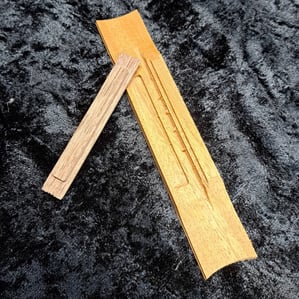
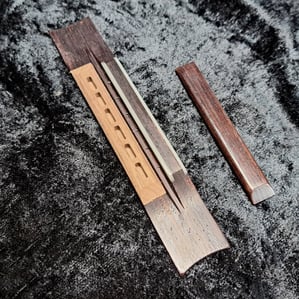
Why Carbon Fibre?
I've been experimenting with carbon fibre (carbon-fibre reinforced plastic, or CFRP) for years. I was initially interested in its stiffness when used in a lattice bracing system (see above), then moved on to consider its strength when protecting guitar necks from travel-related injuries.
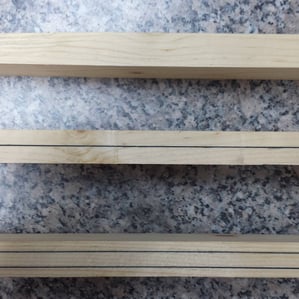
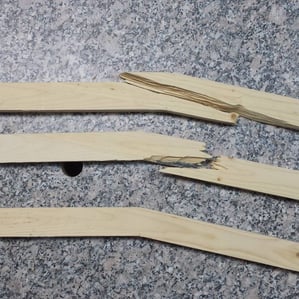
Eventually, I started toying with the idea of a carbon fibre body, which would enable me to build a strong and super-stable test body, on which I could efficiently test out different top designs. That's when I built my first unibody guitar, with a removable top. It was so encouraging, I built a full guitar with the same technique, and put a cedar top on it.

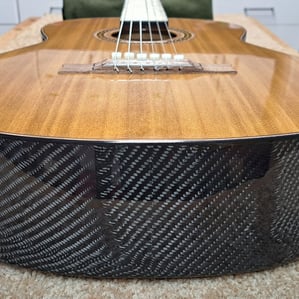
Carbon fibre is interesting stuff. It comes as a cloth, and has to be infused with epoxy to make it stiff and strong. While it's considerably stiffer and stringer than wood, it is also a lot denser. It's also immune to seasonal humidity variations, so won't crack like wood can.
The cloth comes in various thicknesses and weaves, each with their own mechanical characteristics. They can be combined in different ways to target desirable features like strength, tap tone etc that are useful when building guitars.
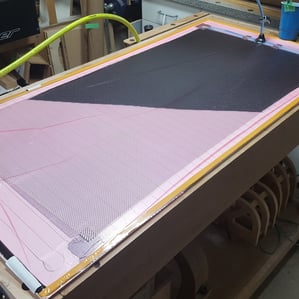
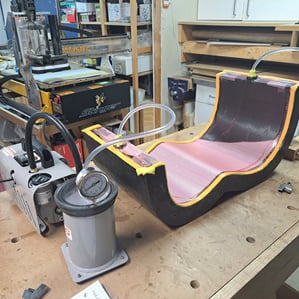
After showing off the guitar for a while, I realized people were asking me the same questions:
Can you make a CF top that won't crack?
Can you make a double-top? and
Can you make it in other colors, like blue?
I've never really like the idea of a wooden double-top guitar. I've had to repair a few, and to me the wooden skins are just too fragile. I also hesitated to build a guitar with a solid CF top, simply because I thought it would be too heavy, and nearly impossible to get the resonant properties I wanted.
After some thinking and experimentation, I realized I could probably make a carbon fibre double-top, and I made it purple because that's my wife's favorite color. Now I have a guitar design that will never need humidification.
Oh - and it also sounds like a guitar. Responsive, resonant, and with excellent sustain. The current design is maybe skewed towards the bright end of the spectrum (think spruce), but I have some ideas to warm it up a bit...
